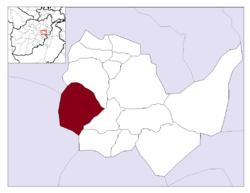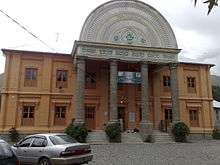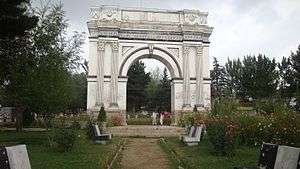Paghman
| Paghman پغمان | |
|---|---|
| List of cities in Afghanistan | |
|
The Victory Arch in the Paghman Gardens | |
 Location in Kabul Province | |
| Country |
|
| Province | Kabul Province |
| Area | |
| • Total | 2,500 km2 (1,000 sq mi) |
| Population (2013)[1] | |
| • Total | 20,900 |
| • Density | 8.4/km2 (22/sq mi) |
| Time zone | AST (UTC+04:30) |
Paghman is a town in the hills near Afghanistan's capital of Kabul. It is the seat of the Paghman District which has a population of about 120,000 (2002 official UNHCR est.), of which 50%are Pashtun and 50% are Tajik.[1] The Paghman District is situated in the western part of Kabul Province. The Paghman Gardens is a major attraction in Paghman, and is why the city is sometimes known as the capital garden of Afghanistan.
History
After King Amanullah Khan and Queen Soraya Tarzi's return from Europe, Amanullah brought in foreign experts to redesign Kabul. At that time, at the entrance of Paghman, they created a European style monumental gate similar to the Arc de Triomphe in Paris, France.

Paghman district borders Wardak and Parwan provinces to the west, Shakardara District to the north, Kabul to the east and Char Asiab District to the south-east. Its headquarters is the town of Paghman, which is situated in the northeastern part of the district.
The district suffered from wars in the region, 50% of the buildings were destroyed and many people fled from the district. Agriculture, labour work, animal husbandry and employment in Kabul are the major sources of income. There are several villages in the district, including Adam Khel Kala, Hatam Kala, Seeno Kala, Mullah Khel Kala, Muhabbat Khan Kala, Lachi Khel Kala, and Pajakk Tappa.
In 2012, 1,000 families in the Paghman district received electricity. The power was distributed to families in the Pracha village of Pashaee valley after the installation of three 1,000 kilovolt transformers. The electricity was supplied to people from the Mahipar Dam in the Sarobi district at the cost of 35 million AFN ($622,443 USD).
About
The Paghman area is greener compared to many other parts of the region, and also has fruit trees. Located at the foot of the Hindu Kush mountain range, Paghman became a holiday retreat with villas and chalets, as well as the summer capital. It was a popular place for the wealthy and the aristocracy to visit. It is known today as a place where people can relax and spend the weekends, and has become an important place for local and foreign tourists.
The Kabul River, the only large river in the Kabul province, is fed by springs and snow-melt runoffs from Paghman. There is also a canal system, in need of repair, which extends from Paghman to Tapa.
Notable natives
Prominent Paghman natives include some leaders of Loya Jirgas, tribal chiefs, a president, and one king.
- King Amanullah Khan - Known as a reformist, Amanullah Khan ruled Afghanistan from 1919 to 1929.
- President Hafizullah Amin - Hafizullah Amin was the second President of Afghanistan during the period of the communist Democratic Republic of Afghanistan.
- Abdullah Wardak, the late governor of Logar Province, was assassinated in an attack by the Taliban on his motorcade near Paghman in September, 2008.
Sister Cities
-
 Alice Springs, Australia, since January 2005 after joining Sister Cities International.[2]
Alice Springs, Australia, since January 2005 after joining Sister Cities International.[2]
References
- 1 2 UNHCR profile for Paghman District
- ↑ "Alice Springs – Sister city media release". Alice Springs Town Council. 9 August 2005. Archived from the original on 20 August 2006. Retrieved 5 July 2007.
External links
Coordinates: 34°35′N 68°57′E / 34.583°N 68.950°E

